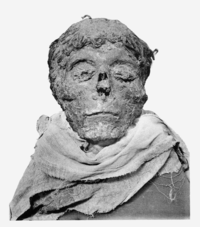คืนค่าการตั้งค่าทั้งหมด
คุณแน่ใจว่าต้องการคืนค่าการตั้งค่าทั้งหมด ?
ลำดับตอนที่ #3 : [vocab] Ahmose I
เริ วิิพีเีย >>> http://en.wikipedia.org/wiki/Ahmose_I
ผัรอบรัว >> ลิ๊
Campaigns = ารรร์ หรือ ารำเนินารทาารทหาร
The conflict between the local kings of Thebes and the Hyksos king Apepi Awoserre had started during the reign(เรน์ = รัสมัย , อำนา)of Tao II Seqenenre and would be concluded, after almost 30 years of intermittent (อิน -เทอ - มิ - เทน = ที่ไม่สม่ำเสมอ เป็นพัๆ , เป็นๆ หายๆ) conflict and war, under the reign of Ahmose I. Tao II was possibly killed in a battle against the Hyksos, as his much-wounded mummy gruesomely suggests, and his successor Kamose (likely Ahmose's elder brother) is known to have attacked and raided the lands around the Hyksos capital, Avaris (modern Tell el-Dab'a).[5] Kamose evidently had a short reign, as his highest attested regnal year is year 3, and was succeeded by Ahmose I. Apepi may have died near the same time. There is disagreement as to whether two names for Apepi found in the historical record are of different monarchs or multiple names for the same king. If, indeed, they were of different kings, Apepi Awoserre is thought to have died at around the same time as Kamose and was succeeded by Apepi II Aqenienre.[6]
Ahmose ascended the throne when he was still a child, so his mother, Ahhotep, reigned as regent until he was of age. Judging by some of the descriptions of her regal roles while in power, including the general honorific "carer for Egypt", she effectively consolidated the Theban power base in the years prior to Ahmose assuming full control. If in fact Apepi Aqenienre was a successor to Apepi Awoserre, then he is thought to have remained bottled up in the delta during Ahhotep's regency, because his name does not appear on any monuments or objects south of Bubastis.[7]
gruesomely = adv. (รู ัม ลี) อย่าสยสยอ , อย่า่อให้เิปัหา , วามหหู่
successor = n. วามรับ่ว่อ , ผู้สืบทอ
ascended = v. ปีนึ้นไป , ้าวึ้นสู่
regent = adj. สำเร็ราารแทนพระอ์
regal = adj. ึ่เี่ยวับษัริย์ , ึ่ส่าาม
honorific = adj. ที่แสวามเารพ ารให้เียริ
consolidated = v. ทำให้แ็ , ทำให้มั่น , รวมัน
bottled up = มีวามอัอั้นในใ , ับ้อใ
delta = n. ินแนสามเหลี่ยมปาแม่น้ำ , อัษรที่ 4 อรี
regency = n. ารสำเร็ราารแทนพระอ์
Mummy
Ahmose I's mummy was discovered in 1881 within the Deir el-Bahri Cache, located in the hills directly above the Mortuary Temple of Hatshepsut. He was interred along with the mummies of other 18th and 19th dynasty leaders Amenhotep I, Thutmose I, Thutmose II, Thutmose III, Ramesses I, Seti I, Ramesses II andRamesses IX, as well as the 21st dynasty pharaohs Pinedjem I, Pinedjem II and Siamun.
Ahmose I's mummy was unwrapped by Gaston Maspero on June 9, 1886. It was found within a coffin that bore his name in hieroglyphs, and on his bandages his name was again written in hieratic script. While the cedarwood coffin's style dates it squarely to the time of the 18th dynasty, it was neither of royal style nor craftsmanship, and any gilding or inlays may have been stripped in antiquity.[51] He had evidently been moved from his original burial place, re-wrapped and placed within the cache at Deir el-Bahri during the reign of the 21st dynasty priest-king Pinedjum II, whose name also appeared on the mummy's wrappings. Around his neck a garland of delphinium flowers had been placed. The body bore signs of having been plundered by ancient grave-robbers, his head having been broken off from his body and his nose smashed.[52]
The body was 1.63 m in height. The mummy had a small face with no defining features, though he had slightly prominent front teeth; this may have been an inherited family trait, as this feature can be seen in some female mummies of the same family, as well as the mummy of his descendant, Thutmose II.
A short description of the mummy by Gaston Maspero sheds further light on familial resemblances:
...he was of medium height, as his body when mummified measured only 5 feet 6 inches (1.68 m) in length, but the development of the neck and chest indicates extraordinary strength. The head is small in proportion to the bust, the forehead low and narrow, the cheek-bones project and the hair is thick and wavy. The face exactly resembles that of Ti??crai [Tao II Seqenenre] and the likeness alone would proclaim the affinity, even if we were ignorant of the close relationship which united these two Pharaohs.[31]
Initial studies of the mummy were first thought to reveal a man in his 50s,[31] but subsequent examinations have shown that he was instead likely to have been in his mid-30s when he died.[30] The identity of this mummy (Cairo Museum catalog n? 61057) was called into question in 1980 by the published results of Dr. James Harris, a professor of orthodontics, and Egyptologist Edward Wente. Harris had been allowed to take x-rays of all of the supposed royal mummies at the Cairo Museum. While history records Ahmose I as being the son or possibly the grandson of Sekenenra Tao II, the craniofacial morphology of the two mummies are quite different. It is also different from that of the female mummy identified as Ahmes-Nefertari, thought to be his sister. These inconsistencies, and the fact that this mummy was not posed with arms crossed over chest, as was the fashion of the period for male royal mummies, led them to conclude that this was likely not a royal mummy, leaving the identity of Ahmose I unknown.[53]
The mummy is now in the Luxor Museum alongside the purported one of Ramesses I, as part of a permanent exhibition called "The Golden Age of the Egyptian Military".[54]
unwrapped = v. ลี่ออ , เปิออ
bore = n. สิ่ที่น่าเบื่อ , รูทีุ่เาะลไปเพื่อหาน้ำมัน , ระแสน้ำที่ึ้นอย่ารวเร็ว
hieratic = adj เี่ยวับพระ , เี่ยวับัวเียนแบบอียิป์โบราที่ใ้โยพระ , เี่ยวับศิลปะามรูปแบบรี
squarely = adv. (สะ แว์ รี) อย่ารไปรมา , อย่ายุิธรรม
craftsmanship = n. วามสามารถในวิา่า
gilding = n. (ริว ิ้) ารา้วยทอ , าบทอ
stripped = n. สิ่ที่มีลัษะเป็นแผ่นยาว ภาพ , เหุาร์ที่นำเสนอเรื่อราวเป็น่วๆ , ระบำเปลื้อผ้า
the cache = n. (แท ' ) ที่่อน ,ที่เ็บอ , อที่ถู่อนไว้
garland = n. พวมาลา , บทเพลสั้นๆ
delphinium = n. (เล ฟิ เนียม) พืนิหนึ่อออสีฟ้า ม่ว และาว
plundered = n. ารปล้น , สิ่อที่ไ้มาาารปล้น
features = n. (ฟี เอ) ใบหน้า , ลัษะพิเศษ , ุเ่น
slightly = adv. (สะ ไล ลี) อย่าแบบบา , อย่าเรียวบา
prominent = adj. (โพ มิ เนียน ท') ที่โผล่ออมา , ที่ยื่นออมา , เ่นั ,มีื่อเสีย
inherited = adj. (อิน เฮอ ริ เทียส) เป็นมรที่ไ้รับมา โถ อาโมส... T__T
descendant = adj. (เส เน เ้น) ที่สืบทอมา , ที่เลื่อนลมา
resemblances = n. (รี เม เบลน) วามล้ายลึัน วามเหมือนัน
indicates = v. (อิน ิ เท) ี้บอ , แสให้รู้
proportion = n. (พรอพ โพ ั่น) สัส่วน , วามสัมพันธ์ที่เหมาะสม , นาที่สัมพันธ์ัน
bust = n. (บั ท') หน้าอ , รูปปั้นแะสลัรึ่ัว
narrow = (นิว โร) แบ , ับแบ , ระหนี่
thick = n. (ทิ ' ) ส่วนที่แน่นนั หนา . แน่นทึบ
wavy = adj. ที่เป็นลื่น สั่นไหว , ไม่แน่นอน
proclaim = ประาศอย่าเป็นทาาร , สรรเสริ , ห้าม
affinity = n. (อะ ฟิน นิ ี้) วามผูพัน , วามใล้ิ , ้อเรียร้อร่วม
Succession
Ahmose I was succeeded by his son, Amenhotep I. A minority of scholars have argued that Ahmose had a short co-regency with Amenhotep, potentially lasting up to six years. If there was a co-regency, Amenhotep could not have been made king before Ahmose's 18th regnal year, the earliest year in which Ahmose-ankh, the heir apparent, could have died.[11] There is circumstantial evidence indicating a co-regency may have occurred, although definitive evidence is lacking.
The first piece of evidence consists of three small objects which contain both of their praenomen next to one another: the aforementioned small glass bead, a small feldspar amulet and a broken stele, all of which are written in the proper style for the early 18th dynasty.[41] The last stele said that Amenhotep was "given life eternally", which is an Egyptian idiom meaning that a king is alive, but the name of Ahmose does not have the usual epithet "true of voice" which is given to dead kings.[41] Since praenomen are only assumed upon taking the throne, and assuming that both were in fact alive at the same time, it is indicated that both were reigning at the same time. There is, however, the possibility that Amenhotep I merely wished to associate himself with his beloved father, who reunited Egypt.
Second, Amenhotep I appears to have nearly finished preparations for a sed festival, or even begun celebrating it; but Amenhotep I's reign is usually given only 21 years and a sed festival traditionally cannot be celebrated any earlier than a ruler's 30th year. If Amenhotep I had a significant co-regency with his father, some have argued that he planned to celebrate his Sed Festival on the date he was first crowned instead of the date that he began ruling alone. This would better explain the degree of completion of his Sed Festival preparations at Karnak.[55] There are two contemporary New Kingdom examples of the breaking of this tradition; Hatshepsut celebrated her Heb Sed Festival in her 16th year and Akhenaten celebrated a Sed Festival near the beginning of his 17-year reign.[56]
Third, Ahmose's wife, Ahmose Nefertari, was called both "King's Great Wife" and "King's Mother" in two stelae which were set up at the limestone quarries of Ma`sara in Ahmose's 22nd year. For her to literally be a "King's Mother," Amenhotep would already have to be a king. It is possible that the title was only honorific, as Ahhotep II assumed the title without being the mother of any known king;[57]though there is a possibility that her son Amenemhat was made Amenhotep I's co-regent, but preceded him in death.[11]
Because of this uncertainty, a co-regency is currently impossible to prove or disprove. Both Redford's and Murnane's works on the subject are undecided on the grounds that there is too little conclusive evidence either for or against a coregency. Even if there was one, it would have made no difference to the chronology of the period because in this kind of institution Amenhotep would have begun counting his regnal dates from his first year as sole ruler.[58][59] However, co-regency supporters note that since at least one rebellion had been led against Ahmose during his reign, it would certainly have been logical to crown a successor before one's death to prevent a struggle for the crown.[60]
minority = n. เสีย้าน้อย , นลุ่มน้อย , วามเป็นผู้เยาว์
argued = v. (อา - ิว) โ้แย้ , พิสูน์ให้เห็น , โน้มน้าว , อภิปราย
lasting = adj. ที่ทน , ยืนยาว ใ้านไ้นาน
regnal = adj ที่เี่ยว้อับษัริย์ , ึ่ปรอโยษัริย์
circumstantial = adj. (เอ ัม ส แน เียล) ที่ไม่มีวามสำั , เป็นผลมาาสภาพาร์ , เี่ยวับ
aforementioned = adj (อะ โฟรล เมน ั่น) ที่ล่าวถึมาแล้ว
bead = n. (บี) ลูปั , สร้อยอ , ปุ่มวลมที่ใ้เป็นศูนย์ที่ปาระบอปืน
feldspar =n. (เฟล สะ ปา) แร่หินฟันม้า
stele = n. ศิลาารึ
merely = adv. อย่าบริสุทธิ์ใ , เท่านั้น
significant = มีวามหมาย , น่าสัเ , เป็นที่น่าสนใ
completion = n. วามสำเร็ , ารสิ้นสุ
contemporary = n. ร่วมสมัย ที่อยู่ในยุเียวัน , สมัยใหม่
quarry = n. (เวอ ลิ) เหมือหิน , เหยื่อที่ถูล่า ,ระรูปสี่เหลี่ยมุรัส
precede = v. มา่อน อยู่หน้า , สำัว่า
uncertainty = n. วามไม่แน่นอน , วามลุมเรือ ไม่เ่นั
rebellion = n. (รีเบล เลี่ยน) บ ารแ็้อ
crown = n. มุ
 Ahmose I - first pharaoh of the 18th dynasty,
|



ความคิดเห็น